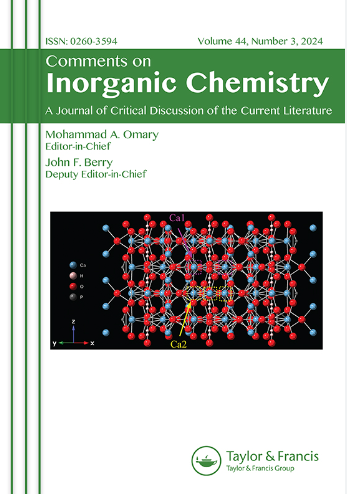一种新型镧系配合物及其纳米包封化合物能否在生物无机化学领域取得进展?镝(III)配合物及其纳米包封物的生物学应用研究
IF 3.8
3区 化学
Q1 CHEMISTRY, INORGANIC & NUCLEAR
引用次数: 0
摘要
摘要本文研究了合成的4,5-重氮芴-9-酮(达丰)配体镝(III)配合物在体外的生物学应用,包括DNA/BSA相互作用、抗菌和抗癌活性。采用多重分光光度法和计算方法研究了镝配合物与牛血清白蛋白(BSA)和鱼DNA (FS-DNA)的结合。通过荧光,吸收,圆二色光谱和粘度测量(仅用于DNA)来评估其DNA和BSA的结合能力。dy -复合物与DNA和BSA结合,具有高的结合常数。对于DNA/BSA结合,热力学参数的负号证实了氢键和范德华力在相互作用过程中起主要作用。与溴化乙啶(EtBr)和罗丹明B的竞争实验表明,dy复合物通过凹槽结合与DNA相互作用。BSA竞争实验表明,dy -复合物与BSA的位点3相互作用,这是对接研究完全安排好的。该复合物具有较高的抗菌和细胞毒性。制备了dy -配合物的纳米载体,并对其抗癌活性进行了测定。(这篇论文展示了一种新的传统,即《无机化学评论》开始发表原创的研究内容,尽管如此,它仍然保留了《无机化学评论》作为当代无机化学文献批判性讨论的小领域的身份。)化学,2018,38,1-35;2019, 39, 1-26;2019, 39, 188-215;2020, 40, 1-24;中国生物工程学报,2016,33 (2):387 - 393;2021, 1-46, doi: 10.1080/02603594.2021.1962310。)本文章由计算机程序翻译,如有差异,请以英文原文为准。
Can One Novel Lanthanide Complex and Its Nano-Encapsulated Compounds Afford Advances in Biological Inorganic Chemistry? A Biological Applications Study for Dysprosium (III) Complex and Its Nano-Encapsulated Compounds
ABSTRACT In this paper, the biological applications of synthetic dysprosium(III) complex, with 4,5-diazafluoren-9-one (dafone) ligand, including DNA/BSA interaction, antibacterial and anticancer activity were studied in vitro. The bovine serum albumin (BSA) and fish DNA (FS-DNA) binding of the dysprosium complex were studied by multi-spectrophotometric as well as computational calculation. Its DNA and BSA binding ability were estimated by fluorescence, absorption, circular dichroism spectroscopy, and viscosity measurements (only for DNA). The Dy-complex binds to DNA and BSA presenting high binding constants. For both DNA/BSA binding, the negative signs of thermodynamic parameter confirmed that hydrogen bonds and van der Waals forces play a main role in the interaction process. The competitive experiments with ethidium bromide (EtBr) and rhodamine B exhibited that the Dy-complex interacts with DNA via groove binding. The BSA competitive experiments showed that Dy-complex interacts with site 3 of BSA, which was completely arranged by docking studies. This complex showed high antimicrobial and cytotoxicity. Besides, nanocarriers of Dy-complex were produced, and the anticancer activities of these compounds were measured. (This paper provides a manifestation of a new tradition by which Comments on Inorganic Chemistry starts publishing original research content that, nonetheless, preserves the Journal’s identity as a niche for a critical discussion of contemporary literature in inorganic chemistry) (For previous manifestations, see Comments Inorg. Chem. 2018, 38, 1–35; 2019, 39, 1–26; 2019, 39, 188–215; 2020, 40, 1–24; 2020, 40, 277–303; 2021, 1–46, doi: 10.1080/02603594.2021.1962310.)
求助全文
通过发布文献求助,成功后即可免费获取论文全文。
去求助
来源期刊

Comments on Inorganic Chemistry
化学-无机化学与核化学
CiteScore
9.00
自引率
1.90%
发文量
18
审稿时长
>12 weeks
期刊介绍:
Comments on Inorganic Chemistry is intended as a vehicle for authoritatively written critical discussions of inorganic chemistry research. We publish focused articles of any length that critique or comment upon new concepts, or which introduce new interpretations or developments of long-standing concepts. “Comments” may contain critical discussions of previously published work, or original research that critiques existing concepts or introduces novel concepts.
Through the medium of “comments,” the Editors encourage authors in any area of inorganic chemistry - synthesis, structure, spectroscopy, kinetics and mechanisms, theory - to write about their interests in a manner that is both personal and pedagogical. Comments is an excellent platform for younger inorganic chemists whose research is not yet widely known to describe their work, and add to the spectrum of Comments’ author profiles, which includes many well-established inorganic chemists.
 求助内容:
求助内容: 应助结果提醒方式:
应助结果提醒方式:


